Article
Discrepancy in vertical tooth positioning may adversely affect anterior dental aesthetics. A simple technique which combines the use of a removable appliance and a composite button can be used effectively for the controlled intrusion of incisors.
The arrangement and position of teeth relative to one another and the surrounding soft tissues largely controls our smile aesthetics. Factors such as anterior crown length, crown width, midline proportions, tooth angulations and vertical tooth position may be critical to anterior dental aesthetics.1 Discrepancy of the incisal edges of the anterior teeth, particularly in the upper jaw, could adversely affect dental aesthetics. In such situations intrusive movement has been recommended to realign the teeth and improve clinical crown length and bone margin levels.2
A light and continuous force (20 grams) is the prerequisite for the effective intrusion of a single anterior tooth. Tooth intrusion should only be attempted when the periodontal condition is under control and pocket depth is no more than 3 mm.2 Fixed orthodontic appliances are the ideal treatment option for tooth intrusion.
Removable appliances are generally viewed as a means of retention after the completion of fixed therapy. It has been reported that, apart from the simple tipping movements of favourably inclined teeth over short distances, removable appliances are unlikely to produce satisfactory results.3
Well controlled tooth intrusion is difficult to achieve with removable appliances. However, when used with some minor modifications, the active wires and acrylic plates can be used effectively to treat uncomplicated cases of incisor intrusion, especially in an adult.
Case report
A 21-year-old male patient presented with the main complaint of incisal edge discrepancy between his upper central incisors. On intra-oral examination, it was found that the incisal edge of his upper left central incisor was positioned 2 mm further incisally than that of the upper right incisor. (Figure 1). The axial crown angulation and inclination of the upper left central incisor was normal. Overjet and overbite were 2 mm and 3 mm, respectively. There was good buccal intercuspation with Class I molar and canine relationship. The periodontal condition was healthy.
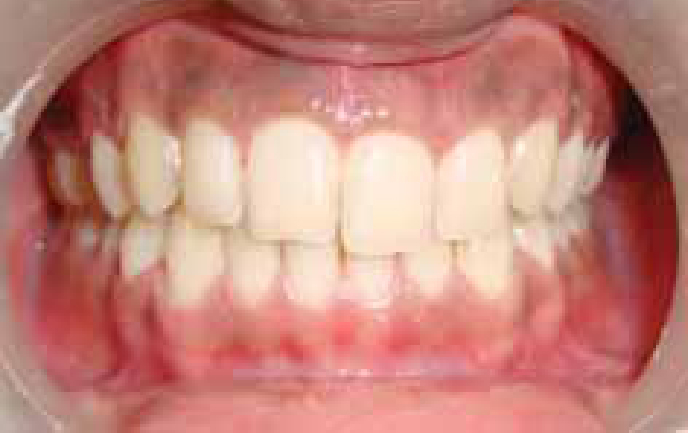
A fixed labial orthodontic treatment was recommended but the patient refused for aesthetic reasons. A lingual orthodontic appliance was also not considered owing to its expense. Therefore a removable appliance was planned to intrude the upper left central incisor. A Hawley type retainer was constructed with Adams clasps on upper permanent first molars (UR6, UL6) and a short labial bow with 0.7 mm stainless steel wire. A custom-made composite button was fabricated on the incisal third of the upper left central as described by Kravitz and Kusnoto4 (Figure 2).
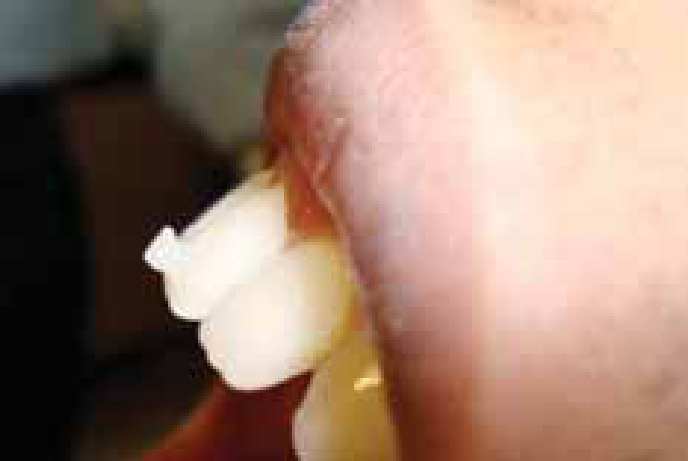
The labial bow was activated to position the bow at the cervical third of the central incisors. It was then placed incisally to engage under the composite button to apply an intrusive force of 20 grams. The ‘U’ loops were compressed to apply a slight lingual force on the incisors (Figure 3). The patient was recalled at 3 week intervals to activate the appliance. The removable appliance was discontinued when the left central incisor was intruded to the incisal level of the adjacent right central incisor (Figure 4). The composite button was then removed with a high-speed tungsten carbide bur. A multistranded stainless steel wire was bonded on the palatal surfaces of the central incisors for retention. The total treatment time was 3 months.
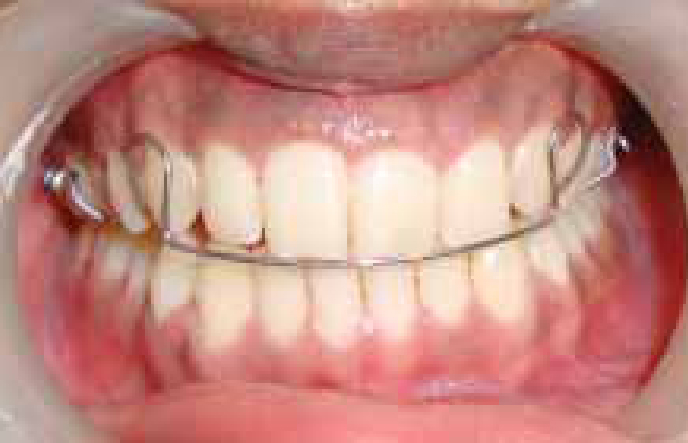
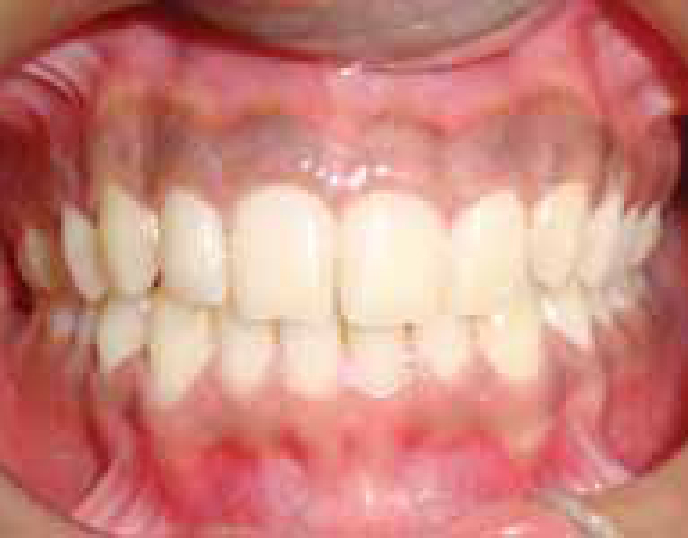
Discussion
Discrepancies of the incisal edges of the anterior teeth may occur due to over eruption, pathological migration and extrusion of the teeth. Anterior teeth are especially prone to elongation since they are not always protected by the occlusion inhibiting pathological extrusion.2
The different treatment modalities available for correcting crown length discrepancies are:
Factors that influence treatment corrections of anterior crown length discrepancies are the sulcus depth of the central incisor, the inferior border of the upper lip height during smiling, relative crown length and the amount of incisal wear of the central incisors.1
In this case, the incisal edge of the upper left central incisor was positioned about 2 mm below that of the upper right incisor and the gingival margin of the upper left central incisor was also positioned more occlusally when compared to the right central incisor. However, there was no wear of the incisal edges of the upper left central incisor. Sulcus depth and crown length were also within normal range. Therefore it was decided to intrude the upper left central incisor to level the incisal as well as gingival margins.
Although a fixed orthodontic appliance would have been an ideal treatment option for the case presented here, a removable appliance was designed owing to cost as well as aesthetic concerns. Controlled intrusive force application is difficult with removable appliances. In the present case, intrusive force was applied by activating the labial bow which applied a force apically (through the composite button) and palatally (Figure 5). The resultant force passed from the centre of resistance of the incisor which resulted in controlled intrusion without any labial or lingual tipping of the upper left central incisor. The custom-made composite button bonded on the labial surface of the upper left central incisor not only provided a site for apical force application but, at the same time, it met with the patient's aesthetic demand. The required intrusion was achieved in 3 months.
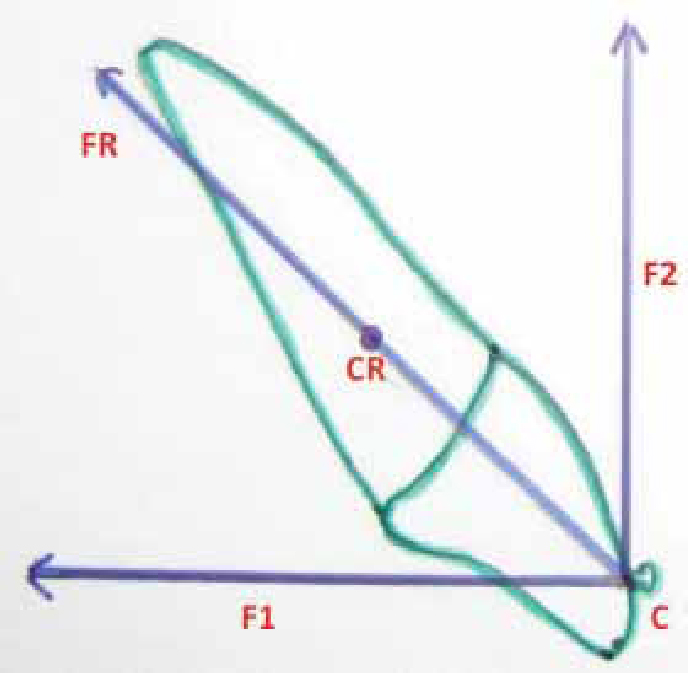
The removable appliance with a labial bow and Adams clasp on the upper permanent first molars had sufficient retention for this case. However, when retention of the appliance is critical, Adams clasps on the premolars can be used for additional retention.
Gingival symmetry should also be taken into consideration while attempting tooth intrusion. Ideally, the gingival margins of the central incisor and the canine are at the same level and the gingival margin of the lateral incisor is 0.5–1 mm more occlusal.1 Although gingival asymmetries are often addressed surgically (periodontal crown lengthening or orthognathic surgery), orthodontic treatment can be an effective method of levelling the gingival planes. For each millimetre that tooth is intruded, the gingival margin moves apically by the same distance.1 In this case, the intrusion of the upper left incisor levelled the gingival margins owing to apical migration of the gingival tissues.
If the gingival margin discrepancies are corrected by levelling the gingival margins orthodontically, these tooth positions should be maintained for at least 6 months to avoid relapse. As teeth are intruded, the orientation of the periodontal fibres change and become more oblique. It typically takes at least 6 months for these fibres to reorient themselves in a horizontal position and stabilize the tooth position.5 For the same reason a multistranded stainless steel wire was bonded on the palatal surfaces of the upper central incisors for retention, this also permits physiological movement of the bonded teeth during function. This technique offers a valuable solution to what might otherwise involve more complex treatment mechanics.
Conclusion
The combination of the custom-made composite button and removable appliance system enables the forces to be controlled in both magnitude and direction with minimal complexity while meeting aesthetic demands.
